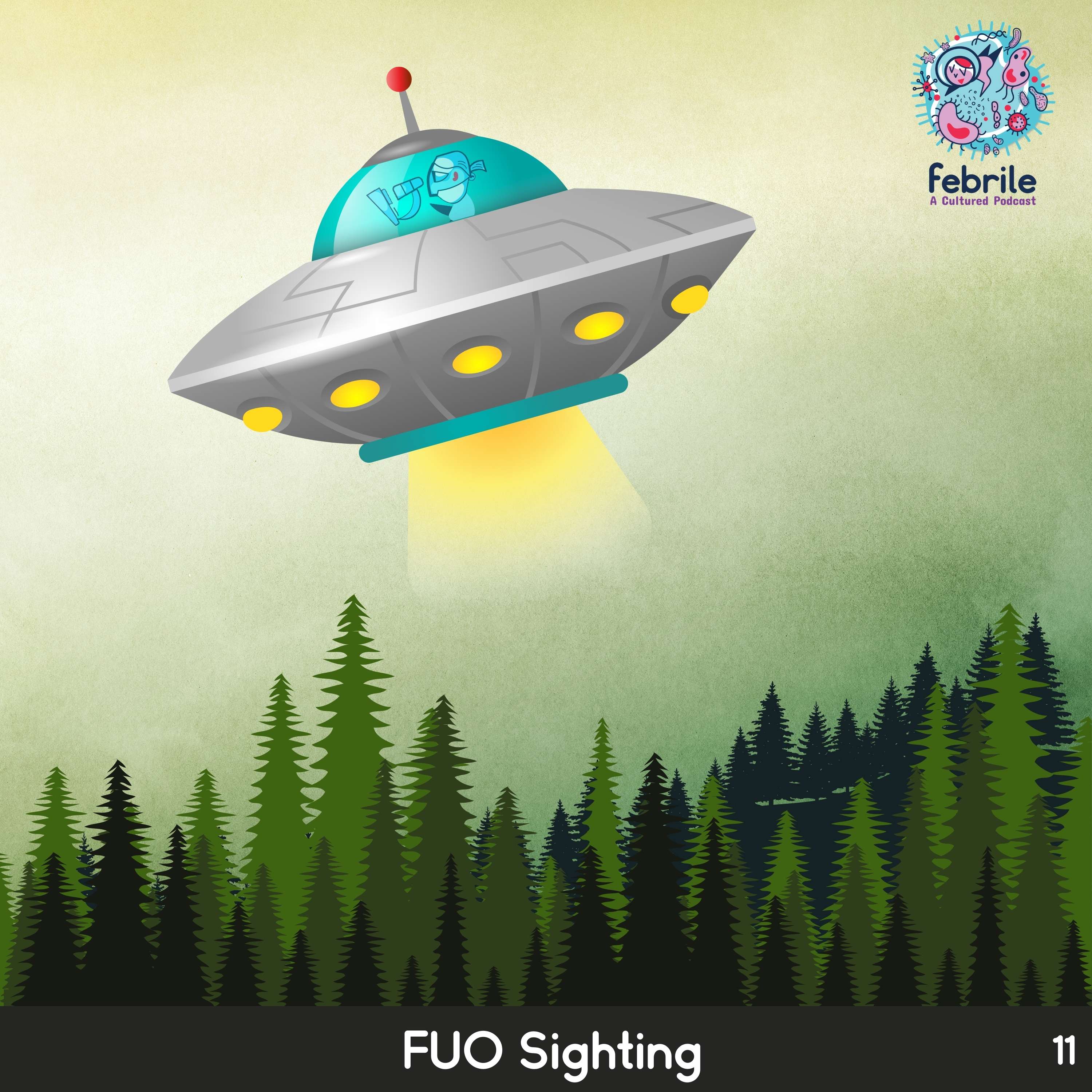Credits
Host: Sara Dong
Guest: Rebecca Wallihan
Writing/Producing/Editing/Cover Art/Infographics: Sara Dong
Our Guest
Rebecca Wallihan, MD

Dr. Wallihan went to Indiana University for medical school, and then moved to Columbus, Ohio where she completed both her pediatric residency and ID fellowship training. She is an Associate Professor of Pediatric Infectious Diseases at Nationwide Children’s Hospital and The Ohio State University. She is also the Pediatric Residency Program Director and Vice Chair of Education for the Dept of Pediatrics.
Culture
Becky likes to listen to true crime and murder mystery podcasts. Check out her pick: My Favorite Murder
Consult Notes
Consult Q
Fever and hepatosplenic lesions in an otherwise healthy girl
One-liner
7 yo previously healthy female with hepatosplenic bartonellosis (B.henselae)
Key Points
Bartonella – An introduction and some microbiology
- The genus Bartonella consists of >20 species, but the best known is Bartonella henselae
- Did you know that B.henselae was not identified as the etiology of cat-scratch disease until 1983? CSD was first reported in the 1950s!
- Other Bartonella species to remember:
- Bartonella quintana: agent of louse-borne trench fever
- Bartonella bacilliformis: Carrion disease (Oroya fever; verrucaperuana); arthropod vector is sandfly; endemic only in Andes mountains in western South America
- Other species have been causes of endocarditis as well (B.elizabethae, B.alsatica)
- Both B.henselae and B.quintana have been identified as causes of bacillary angiomatosis, bacillary peliosis, bacteremia, and endocarditis
- Fastidious, slow-growing, pleomorphic gram-negative bacilli. Facultatively intracellular
B.henselae – Epidemiology and Transmission
- Major reservoir: domestic cat
- Causes an intraerythrocytic bacteremia that can persist for a year or longer in some cats
- Cat to cat transmission via cat flea (Ctenocephalides felis) with feline infection resulting in asymptomatic bacteremia often weeks to months
- Fleas acquire the organism when feeding on bacteremic cat, and then shed infectious organisms in their feces
- Seroprevalence has been reported anywhere from 15-90% in domestic and stray cats in the US
- Other animals can be infected though (like dogs)
- Within humans, B.henselae invades endothelial cells causing an acute inflammatory reaction associated with activation of proinflammatory cascade
- Transmission:
- Bacteria are transmitted to humans by inoculation thru a scratch, lick, bite from bacteremic cat
- Bacteria can also contaminate hands by flea feces, which then touch open wound or eye
- No convincing evidence of person-to-person transmission or that ticks are competent vector
- Most patients have history of recent contact with apparently healthy cats or kittens
- Kittens are more often bacteremic than older cats
- Worldwide distribution and a common cause of regional lymphadenopathy/lymphadenitis in children
- Most cases occur in fall and winter. Seasonality may be related to cat reproductive cycles in combination with flea activity? (kittens born in midsummer with high flea activity)
- True incidence of human infection is unknown
- Cat scratch disease occurs in immunocompetent individuals and infrequently will cause serious illness, but systemic Bartonella infection is described as well.
- Highest incidence of CSD: 5-9 year olds
- Incubation period from time of scratch to appearance of cutaneous lesion: 7-12 days
- Period to appearance of LAD is 5-50d (median 12d)
- Jackson LA, Perkins BA, Wenger JD. Cat scratch disease in the United States: an analysis of three national databases. Am J Public Health. 1993;83(12):1707-1711. doi:10.2105/ajph.83.12.1707
B.henselae and cat scratch disease (CSD)
- Cat scratch disease is a local bacterial infection caused by Bartonella henselae
- The predominant manifestation in an immunocompetent patient is regional lymphadenopathy or lymphadenitis after a scratch or bite from cat
- Skin papule or pustule at site of inoculation, which then leads to regional lymphadenopathy (where the area drains too) a few weeks later
- Affected lymph node is enlarged, tender, freely movable
- Most frequently affects the axillary, epitrochlear, head and neck lymph nodes (where children are often scratched/bitten/licked), but can present with femoral, inguinal, or popliteal LAD
- 10-25% of affected nodes will suppurate spontaneously
- Often this infection is self-limited with mild systemic symptoms, and typically lymphadenopathy will resolve spontaneously in about 2-4 months
- Fever and associated systemic symptoms may be present in about 25-30% of patients
B.henselae and other clinical presentations (systemic or atypical CSD): Bartonella infection can affect many organ systems and remains on many differential diagnoses! It has a broad spectrum of atypical clinical syndromes, which likely reflect bloodborne disseminated disease. This episode’s case highlighted hepatosplenic disease and prolonged fever, which can be a fairly common presentation in children.
- Prolonged fever or fever of unknown origin (FUO)
- Hepatic and/or splenic lesions
- Osteomyelitis → Becky emphasized the association of Bartonella with vertebral or pelvic girdle osteomyelitis in children!
- Culture negative endocarditis
- Encephalopathy, encephalitis, aseptic meningitis
- Ocular disease (5-10% of patients)
- Neuroretinitis: most classic and frequent presentation of ocular Bartonella infection
- Unilateral painless vision loss in most cases. Simultaneous bilateral involvement is rarely reported
- Granulomatous optic disc swelling, macular edema with lipid exudates (macular star)
- Parinaud oculoglandular syndrome (really a specific presentation of cat-scratch disease)
- Follicular conjunctivitis
- Ipsilateral lymphadenopathy: preauricular is classic but could be submandibular or cervical lymph nodes
- Fever
- Site of inoculation is eyelid or conjunctiva
- Rare ocular disease: retinochoroiditis, anterior uveitis, retinal vasculitis, retinal detachments, and more
- Neuroretinitis: most classic and frequent presentation of ocular Bartonella infection
- Other rare presentations: glomerulonephritis, erythema nodosum, thrombocytopenia purpura
- Few references:
- Goodman B, Whitley-Williams P. Bartonella. Pediatr Rev. 2020;41(8):434-436. doi:10.1542/pir.2019-0198
- Florin TA, Zaoutis TE, Zaoutis LB. Beyond cat scratch disease: widening spectrum of Bartonella henselae infection. Pediatrics. 2008;121(5):e1413-e1425. doi:10.1542/peds.2007-1897
- Carithers HA. Cat-scratch disease. An overview based on a study of 1,200 patients. Am J Dis Child. 1985;139(11):1124-1133. doi:10.1001/archpedi.1985.02140130062031
- Landes M, Maor Y, Mercer D, et al. Cat Scratch Disease Presenting as Fever of Unknown Origin Is a Unique Clinical Syndrome. Clin Infect Dis. 2020;71(11):2818-2824. doi:10.1093/cid/ciz1137
- Dunn MW, Berkowitz FE, Miller JJ, Snitzer JA. Hepatosplenic cat-scratch disease and abdominal pain. Pediatr Infect Dis J. 1997;16(3):269-272. doi:10.1097/00006454-199703000-00003
- Baranowski K, Huang B. Cat Scratch Disease. In: StatPearls. Treasure Island (FL): StatPearls Publishing; June 23, 2020.
We quickly touched on a few separate entities that can be caused by Bartonella, largely in immunocompromised hosts:
- Bacillary angiomatosis
- Rare disorder with vascular proliferative lesions of skin and subcutaneous tissue
- Gradual appearance of reddish-brown lesions, which can be verrucous, papular, pedunculated
- Often erythematous base with vascular appearance, but can also have dry/scaly, hyperkeratotic, or plaque-like appearance
- Can appear similar to Kaposi sarcoma or pyogenic granuloma
- Bacillary peliosis
- Reticuloendothelial lesions in visceral organs, primarily the liver (peliosis hepatitis)
- Can also involve spleen, abdominal lymph nodes, bone marrow
- The visceral lesions of bacillary peliosis can be accompanied by cutaneous lesions seen in bacillary angiomatosis
- These cases are generally diagnosed by biopsy and have characteristic histologic appearance
- Attempts to culture Bartonella in these cases might be more successful than those specimens from typical cat-scratch disease
- Lesions and symptoms usually respond rapidly to therapy
Diagnosis of Bartonella henselae infection
- As mentioned above, Bartonella is fastidious and isolation in culture is difficult→ so often can’t rely on blood or tissue cultures for diagnosis
- Serology is the mainstay of diagnosis for Bartonella
- Indirect immunofluorescent Ab (IFA) assay for serum Ab to antigens of Bartonella spp
- Any IgM positivity suggests acute or recent infection, but IgM production is brief and could be missed → so low test sensitivity
- Generally if IFA IgG titer is <1:64, patient does not have acute infection
- IgG titer >1:256 is considered indicative of acute or recent infection
- There is a gray zone with IgG titers between 1:64 and 1:256 that may represent past or acute infection → if here, can repeat titers in 2-4 weeks to see if there is a rise
- Cross-reactivity between B.henselae and B.quintana or other Bartonella species is common
- Indirect immunofluorescent Ab (IFA) assay for serum Ab to antigens of Bartonella spp
- PCR assays are available and can be adjunct diagnostic
- Would not routinely get blood PCR given poor sensitivity
- This is mostly helpful on tissue specimens (such as valvular tissue in endocarditis or lymph node biopsy)
- Histopathology
- If tissue is available, bacilli can occasionally be visualized using silver stain (e.g. Warthin-Starry or Steiner stain), however this is not specific for B.henselae
- Early histologic changes in lymph node specimens: lymphocytic infiltration, epithelioid granuloma formation
- Later histologic changes: PMN infiltration, necrotizing granulomas
- May resemble granulomas in patients with tularemia, brucellosis, mycobacterial infections
- Alattas NH, Patel SN, Richardson SE, Akseer N, Morris SK. Pediatric Bartonella henselae Infection: The Role of Serologic Diagnosis and a Proposed Clinical Approach for Suspected Acute Disease in the Immunocompetent Child. Pediatr Infect Dis J. 2020;39(11):984-989. doi:10.1097/INF.0000000000002852
Treatment of Bartonella
- Localized uncomplicated cat scratch disease may be self-limited with spontaneous resolution in 2-4 months. Experts often recommend treating these cases with a 5 day course of Azithromycin though, in an attempt to avoid future complications.
- Suppurative painful nodes may require needle aspiration for relief, but I&D runs risk of fistula formation
- Surgical excision generally unnecessary
- Severe systemic illness in immunocompetent patients and all immunocompromised patients should be treated. B.henselae is susceptible to wide range of antibiotics:
- Tetracyclines (doxycycline)
- Macrolides (azithromycin, clarithromycin)
- Trimethoprim-sulfamethoxazole
- Rifampin
- Fluoroquinolones
- Aminoglycosides
- Later generation but not first generation cephalosporins
- Azithromycin monotherapy has been shown to have modest benefit in reduction of lymph node volume after 1 month (vs placebo)…but no other differences in clinical outcome.
- Experts often recommend dual or combination therapy for more severe disease
- This is frequently: macrolide (azithromycin) + rifampin
- Other combinations might include: TMP-SMX + Rifampin, Doxy + Rifampin, Rifampin + Gent
- Neuroretinitis often is treated with systemic antibiotics (e.g. Doxy + Rifampin x 4-6 wks) and steroids to decrease optic disc swelling and promote more rapid return of vision
- Corticosteroids might be considered in severe or persistent disease other than neuroretinitis, but efficacy is unclear
- Bryant K, Marshall GS. Hepatosplenic cat scratch disease treated with corticosteroids. Arch Dis Child. 2003;88(4):345-346. doi:10.1136/adc.88.4.345
- Phan A, Castagnini LA. Corticosteroid Treatment for Prolonged Fever in Hepatosplenic Cat-Scratch Disease: A Case Study. Clin Pediatr (Phila). 2017;56(14):1291-1292. doi:10.1177/0009922816684606
- The best endocarditis regimen is unknown, but many would recommend doxycycline + aminoglycoside
- Of note, we typically avoid doxycycline in children under the age of 8 due to concerns about dental staining → but in cases of sight-threatening neuroretinitis or severe neurologic disease, it would be important to discuss risk/benefits of doxycycline.
- Limited data but most studies on neuroretinitis treatment used doxycycline + rifampin
- The optimal duration of therapy is unknown
- Many would consider starting with 10-14 days of treatment for hepatosplenic disease, but patient may require much longer courses on the order of months (especially for CNS disease or neuroretinitis)
- Can sometimes use inflammatory marker trends
- Total duration depends on site of infection and patient’s clinical course
- We really just have anecdotal guidance for treatment (other than the azithro trial above) — Recommendations for treatment of bartonellosis rely largely on personal experience and expert opinion due to lack of data!
- Few other references:
- Prutsky G, Domecq JP, Mori L, et al. Treatment outcomes of human bartonellosis: a systematic review and meta-analysis. Int J Infect Dis. 2013;17(10):e811-e819. doi:10.1016/j.ijid.2013.02.016
- Rolain JM, Brouqui P, Koehler JE, Maguina C, Dolan MJ, Raoult D. Recommendations for treatment of human infections caused by Bartonella species. Antimicrob Agents Chemother. 2004;48(6):1921-1933. doi:10.1128/AAC.48.6.1921-1933.2004
- Margileth AM. Antibiotic therapy for cat-scratch disease: clinical study of therapeutic outcome in 268 patients and a review of the literature. Pediatr Infect Dis J. 1992;11(6):474-478.
- Shorbatli LA, Koranyi KI, Nahata MC. Effectiveness of antibiotic therapy in pediatric patients with cat scratch disease. Int J Clin Pharm. 2018;40(6):1458-1461. doi:10.1007/s11096-018-0746-1
Check out some of the graphics for possible causes of hepatic and/or splenic lesions! Here are a few references:
- Choi EK, Lamps LW. Granulomas in the Liver, with a Focus on Infectious Causes. Surg Pathol Clin. 2018;11(2):231-250. doi:10.1016/j.path.2018.02.008
- Lamps LW. Hepatic Granulomas: A Review With Emphasis on Infectious Causes. Arch Pathol Lab Med. 2015;139(7):867-875. doi:10.5858/arpa.2014-0123-RA
We’ve also discussed FUO in prior episodes as well. You can refresh with the prior graphics in the Episode Art & Infographics section.
A reference for the Parinaud’s oculoglandular graphic: Arjmand P, Yan P, O’Connor MD. Parinaud oculoglandular syndrome 2015: Review of the literature and update on diagnosis and management. J Clin Exp Ophthalmol. 2015;6;443. DOI: 10.4172/2155-9570.1000443
Other miscellaneous mentions and notes:
- Like textbook references?
- Mandell, Principles and Practice of ID, 8th Ed., 9th Ed.:
- Chapter 236: Bartonella, including Cat-Scratch Disease
- Long, Principles and Practice of Pediatric ID, 5th Ed.:
- Chapter 160: Bartonella Species (Cat Scratch Disease)
- Chapter 181: Other Gram-Negative Coccobacilli > Bartonella species
- Comprehensive Review of Infectious Diseases
- AAP Red Book
- Mandell, Principles and Practice of ID, 8th Ed., 9th Ed.:
Episode Art & Infographics
Goal
Listeners will be able to identify Bartonella henselae as the agent in cat scratch disease
Learning Objectives
After listening to this episode, listeners will be able to:
- Identify different clinical presentations of Bartonella infection
- Discuss the use and challenges of serology for diagnosis of Bartonella
- List the available antimicrobials for cat scratch disease
Disclosures
Our guest (Rebecca Wallihan) as well as Febrile podcast and hosts report no relevant financial disclosures
Citation
Wallihan, R., Dong, S. “#11: FUO Sighting”. Febrile: A Cultured Podcast. https://player.captivate.fm/episode/d8858088-e6fe-4b1b-a867-6c099b3f1500



